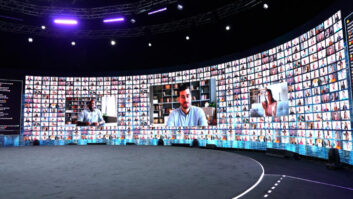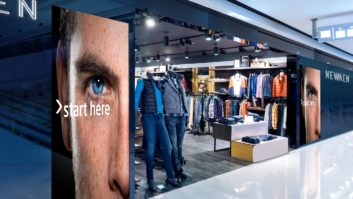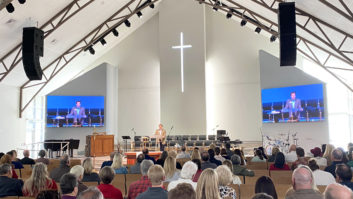If the expression ‘may you live in interesting times’ is to be employed as an historical barometer, then the last few years have been extremely interesting indeed. No shortage of challenges – Covid-19, a huge spike in remote working, accelerating digitisation and so on – have confronted businesses, and brought with them massive implications for their use of technology.
No prizes for guessing that the most significant one for many businesses during the pandemic era was how best to enable remote working and collaboration. Faced with a pressing need to review their communications infrastructure, there was inevitably a tendency in some quarters to adopt short-term fixes based around basic conferencing options and off-the-shelf gear. With remote working now solidified into a permanent part of many companies’ operations, it’s inevitable that many organisations are in the process of reviewing their ability to capture, stream and store high-quality content. Indeed, it’s clear that broadcast-quality AV is now an expectation – not just an item for the wish-list.
Fortuitously, this development is occurring at precisely the same time that broadcast and AV are converging in multiple ways. With IP-based networking arguably the most important single enabler, there is now more crossover of solutions between the two markets than ever before. And with the migration to the cloud – including for ultra-low latency live productions – accelerating, it’s likely that at least part of each company’s core workflow will have a cloud element.
 In this article, we’ll look at the implications of using broadcast-quality equipment in pro AV implications, from both solutions and skills perspectives; the current availability of AV-oriented training around broadcast-type gear; the areas that require most urgent attention with regard to primary skill-sets; and the scope for more shared training in the future as the convergence of broadcast and AV matures.
In this article, we’ll look at the implications of using broadcast-quality equipment in pro AV implications, from both solutions and skills perspectives; the current availability of AV-oriented training around broadcast-type gear; the areas that require most urgent attention with regard to primary skill-sets; and the scope for more shared training in the future as the convergence of broadcast and AV matures.
Among those interviewed for this feature, there was a general consensus that the convergence – with all its potential benefits and pitfalls – is most acute in corporate AV. It’s in this market where the crossover of systems – especially those used to produce and distribute video content – is most fertile. And with the resources of the larger corporations, in particular, it’s also where there tends to be the greatest available budget to implement broadcast-quality infrastructures.
Ben Wolk is managing partner of Seattle-based AV integration and engineering company ZTransform. With interests in broadcast, corporate, education and government sectors, the company is well-placed to track the recent convergence in disciplines. “I can say with all certainty that it’s the corporate space where we are seeing this the most,” says Wolk. “It has a tremendous need in the marketing and PR part of the business, and that often brings with it a very heavy video requirement.”
Noting that he is currently working on a blog text about how corporations can end up as ‘accidental media companies’, Wolk implies that many larger companies, in particular, now effectively have their own content operation. “If you look at the combination of large event AV with broadcast AV and streaming, [it’s a real blend] of how a company wants not only to generate high-level content, but also provide elements of the media itself and then distribute the content over streaming platforms.”
Wolk is not alone in suggesting that the pandemic has “expedited this kind of communication need – not only for internal communications, although that’s definitely a big factor, but also to develop their own corporate culture and establish missions statements and goals. [With the appropriate technology] it can be very powerfully done”.
Intriguingly, although it’s corporate where the convergence is actually proceeding most rapidly, Wolk suggests it’s actually sports venues where the trend first became pronounced. A combination of AV and broadcast gear has long been in place there: from AV the huge screens and LED walls, added to which is a broadcast component that “not only goes to the outside world, but also the inside production that feeds what the audience watches.”
KEY ENABLER
There is no doubt that one of the key enablers of convergence is networking and cabling infrastructure. With 4K now becoming ubiquitous, significant video processing and transportation requirements are no longer the preserve of broadcast centres and OB trucks. Inevitably, this has resulted in more companies – especially those who produce connectivity products – delivering solutions to multiple sectors, despite having primarily focused on broadcast or AV in their earlier days.
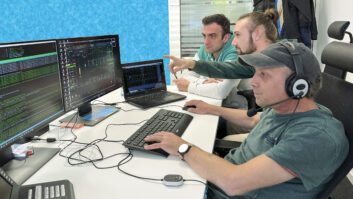 Chris Smeeton is director of Argosy, which describes itself as a ‘one stop shop’ for pro video, audio, data, fibre and racking products. Traditionally, the company was focused on supplying into the TV broadcast sector, but “since about 2015/16 we have started to see clients from adjacent markets come to us when they are using broadcast equipment in their operations. For example, it could be a house of worship or a garden centre where they are putting up large screens and a centralised control system” – the latter increasingly likely to be provided by broadcast-grade equipment.
Chris Smeeton is director of Argosy, which describes itself as a ‘one stop shop’ for pro video, audio, data, fibre and racking products. Traditionally, the company was focused on supplying into the TV broadcast sector, but “since about 2015/16 we have started to see clients from adjacent markets come to us when they are using broadcast equipment in their operations. For example, it could be a house of worship or a garden centre where they are putting up large screens and a centralised control system” – the latter increasingly likely to be provided by broadcast-grade equipment.
Smeeton’s own personal moment of realisation about the convergence began a few years back when Argosy made its ISE exhibitor debut. “We went there assuming that not many people would have heard of us,” he recalls. “But one day we got talking to an AV installer about cables and that a started a dialogue between us. Eventually, we ended selling them mains distribution units, KVM switchers, and so on; all generally expensive stuff. And when we found out the kit was going to Dubai for an install, we made them aware that we had an office there that could support them. So it shows that things can develop in unexpected ways, although whether it’s AV, IT or broadcast, people buy cables and connectors, and need rack rooms to house them in, so we are seeing a lot of convergence there.”
If it’s beyond doubt that broadcast and AV’s convergence is most apparent in corporate, then it also follows that there are going to be potentially significant implications for skills and training. One might imagine that the shortfall would be primarily on the side of pro AV as technicians and end-users get to grips with broadcast-quality switchers and video broadcast systems – and that is certainly an important factor. But with some of the more traditional training structures falling away, it’s a hot topic in broadcast too.
As Smeeton points out: “What we have traditionally seen in broadcast is that the major broadcasters had apprenticeships and training programmes, but I think that is happening less and less. It’s now not so much to do with the [broadcasters] and more linked to independent training and consultants.” He singles out the IABM for addressing this problem and working to resolve various skills issues.
Initiatives such as the ST 2110 standards – devised primarily for broadcast but now used in other environments – have definitely helped to enable convergence. Nonetheless, configuring and managing an “IP network is something that requires the same kind of skillset [in broadcast and AV],” says Smeeton.” Then when you bring in different aspects – for example, doing 4K over IP – there is also an IT skillset that fits into both spaces.”
In addition, broadcast is facing a generational shift that is not so acute in pro AV. We have reached a stage in the cycle where many senior engineers at broadcasters are retiring, and they are not necessarily proving easy to replace. It’s a point that’s explored by Glodina Lostanlen, chief process officer for Imagine Communications.
STAFF MOVEMENT
Increasingly, personnel in broadcast companies are being “drawn from the IT industry a lot, but they have to learn the world of media and 24/7 broadcast environments,” she says, adding that this tends to involve a step-change in “expectations around resilience”. In contrast to the broadcast engineers of yore who might have stopped at the same employer for the majority of their careers, there is also a “tendency to move on after a couple of years. I very much doubt that [many engineers] will stay with the same broadcaster for 30 or 40 years in future, as used to be the case”.
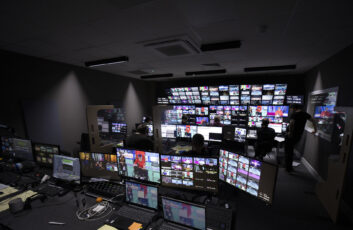 In terms of Imagine’s own approach to personnel, there is a firm emphasis on “building on their skill sets – which can sometimes be quite unique – and developing them so they understand how best to use our equipment in a variety of contexts. That is a big part of it”.
In terms of Imagine’s own approach to personnel, there is a firm emphasis on “building on their skill sets – which can sometimes be quite unique – and developing them so they understand how best to use our equipment in a variety of contexts. That is a big part of it”.
Nick Fletcher is founder and CEO of Nixer Pro Audio, whose audio over IP monitoring and diagnostic tools are now used widely across broadcast, live, install and AV industries. “From our perspective, what we are seeing as the biggest skill set that is lacking and needs attention is networking,” he says. “It’s not to do with audio itself, which tends to have a nice and cosy feeling to it, but the networking side which perhaps appears not so interesting [to outsiders] but is actually hugely important in terms of having the necessary skills.”
He cites the example of an organisation he is aware of who “installed a network backbone in a facility and then had all equipment plugging into that! So it can be the basics [that are lacking] with regard to installing cables and switches into a facility, as well as understanding how to prepare redundancy as well as achieve remote access and management”.
Fletcher indicates that the industry shortfall in this regard could have its roots in a perception problem. “It could be that networking is not perceived as being quite so glamorous as audio, and instead is seen as being a bit mundane perhaps,” he says. But the reality is there is a great deal to be learned and done there, with regards to installing and operating networks and backbone infrastructures.”
This will have to be addressed as soon as possible given that that continued convergence – especially around IP for audio and video – is beyond doubt. Noting the pro AV and broadcast origins of Audinate’s Dante and the Ravenna IP technologies, respectively, he says that “some companies are now having both [technologies].”
Meanwhile, it’s also important for a wide range of operational environments that technicians can manage and operate the older equipment with just as much elan as the newer tech. Andreas Hilmer is director of marketing & communications at Lawo, whose solutions are used in broadcast, live performance and theatre. He says that there is a danger that new recruits might not be sufficiently familiar with “legacy or existing gear” used by a wide customer base.
 Focusing on broadcast in particular, he adds: “Having trained customer-facing and knowledgeable DeVop staff is one thing. Allowing your customers to leverage the full potential of the solutions they purchased is even more important. Far from being a self-serving initiative, well-trained operators who are aware of what is, and is not, possible will save their employers (or customers) a tremendous amount of man hours, which ultimately allows the latter to stay on air and produce more compelling content with an optimised toolset.”
Focusing on broadcast in particular, he adds: “Having trained customer-facing and knowledgeable DeVop staff is one thing. Allowing your customers to leverage the full potential of the solutions they purchased is even more important. Far from being a self-serving initiative, well-trained operators who are aware of what is, and is not, possible will save their employers (or customers) a tremendous amount of man hours, which ultimately allows the latter to stay on air and produce more compelling content with an optimised toolset.”
With many core technologies now shared by both broadcast and AV, the questions inevitably arise: Will we see more combined training courses for both sectors in the future? And is there is scope for more technical standards developed jointly as opposed to individual sector-based alliances, as has historically been the case?
“I think that [combined courses and training] could be the way to go,” says Smeeton. “We have been approached on a number of occasions at broadcast and tech shows about the possibility of contributing to courses. At a very basic level that could be about how to terminate cables, dress a rack and so on. Some skill sets are definitely general [to both sectors] and with so many companies now doing video over networks, that is also an area where there is convergence [and you can do shared training] about best practice.”
It helps in this regard that there has been an increase in the availability of multi-disciplinary media technology training, as offered by the likes of Ravensbourne and UWE Bristol, to name just two in the UK. But at least for now, companies looking to bolster their technical personnel are “probably best to have an AV or IT person and then teach them some specific broadcast stuff than the other way around,” suggests Smeeton.
SKILLS SHORTAGES
Indeed, much as the main public focus might be on the skills shortages at the national or global broadcaster level, it’s fair to say that most companies are grappling with some variation of the problem. A recent scaling-up of activities has highlighted this to Argosy. “Demand came back very quickly [after the pandemic] and we have been doing a lot of investment in our team to get to a certain level,” says Smeeton. “But we are very booked out and [time has to be spent] working out how to staff the next projects when you have 3 or 4 going at the same time. For a company our size, it’s always going to be a challenge to get the right people with the right mentality as the biggest danger to growth is a slip in quality – and that is unacceptable at our company.”
Ultimately, though, it’s an area that will benefit from universal action by employers and trade associations. No area in which broadcast or AV tech is utilised will be exempt from the impact of a generational shift and a diminished pool of available talent. But action at an individual company level to inspire employees and provide them with an appealing working environment, culture and long-term developmental prospects is also going to be more critical. With more transferable skills to call on, the most gifted newcomers will be able to have their pick of employers and sectors.
“Coupled with a shrinking population in most parts of the world, it will be harder to secure the human and brainpower a vendor or broadcaster needs moving forward,” says Hilmer. In which context, those “immaterial perks – such as solutions worth working hard for and a team spirit where you can count on someone having your back – are more important than ever.”

